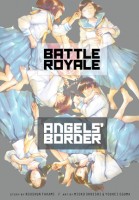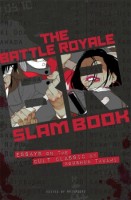 Author: Koushun Takami and N-Cake
Author: Koushun Takami and N-Cake
Illustrator: Mioko Ohnishi and Youhei Oguma
U.S. publisher: Viz Media
ISBN: 9781421571683
Released: June 2014
Original release: 2012
In 1999 Koushun Takami’s controversial cult classic Battle Royale was released upon the world, the novel soon after spawning a fifteen-volume manga adaptation illustrated by Masayuki Taguchi and inspiring two live-action films. I became a fan of the original novel after reading the 2009 English translation, and so was very interested to learn that Takami (with the assistance of N-Cake) had returned to Battle Royale with the manga Angels’ Border. Released in Japan in 2012, the collected volume includes two related episodes about the young women whose efforts to survive a brutal government sponsored death match by grouping together end in tragedy. The first story is illustrated by Mioko Ohnishi while the second is illustrated by Youhei Oguma. I was happy that Viz Media licensed Battle Royale: Angels’ Border, releasing the manga under its Signature imprint in 2014. Angels’ Border makes a nice addition to Viz’s other recent Battle Royale releases: The Battle Royale Slam Book, and a new English translation of Takumi’s original novel.
Every year a class of ninth grade students from the Republic of Greater East Asia is selected to participate in the Program. The students are given a small survival pack, a random weapon, and forced into a situation where they must either kill or be killed. In the end, only one person will survive. This year’s Program pits the forty-two students of Shiroiwa Junior High’s ninth grade, Class B against each other. Under the leadership of Yukie Utsumi, six of the girls band together, taking shelter in the lighthouse on the island serving as the Program’s arena. There they hope to avoid and wait out most of the violence. The group includes her best friend Haruka Tanizawa, who has recently come to the realization that she is in love with Yukie, though she hasn’t been able to confess those feelings. Another girl at the lighthouse, Chisato Matsui, has her own secret—she shares a special connection with Shinji Mimura, a star basketball player with smarts, good looks, and dangerous anti-government tendencies. But because she has joined up with the other young women for safety, it is unlikely that she will ever see him again.
People who have read the original Battle Royale, or who have experienced its adaptations, know very well how the incident at the lighthouse plays out; those who haven’t can probably very easily guess. Most (but not all) of the violence occurs off-page in Angels’ Border, but the characters still have to deal with its aftermath. The atmosphere at the lighthouse is strained but relatively quiet; the tension, fear, and despair is present even as the young women are resigning themselves to their fates. They witness the deaths of their fellow students and try to come up with excuses for the classmates who have resorted to killing one another, partly because they are in denial about what is happening and partly because the entire situation is incomprehensible to them. For a time they are safe, but every decision that they make for their own survival has an impact on the survival of everyone else forced to participate in the Program. The alliance formed by the six young women and their trust in one another are extraordinarily fragile things. None of them want to kill, but none of them want to die either, even though they know it will be impossible for all of them so survive. The result is a highly stressful and volatile scenario.
Generally, Angels’ Border can be read on its own, but it will probably appeal most to those who are at least familiar with Battle Royale. I hadn’t anticipated it when I began reading Angels’ Border, but both of the manga’s episodes are actually love stories. Granted, because they occur within the context of Battle Royale, they are both dramatic romantic tragedies. The first story is told by Haruka as she deals with what she sees as the futility of her feelings for Yukie as well as with the futility of the situation in which they find themselves. She reflects briefly on their past friendship, but generally the episode’s focus is on their unfortunate present and bleak future. The second story is seen from Chisato’s perspective. Much of it is devoted to a single encounter between her and Shinji six months before the start of the Program. Both episodes are more about the characters’ interpersonal relationships than they are about death and violence, although those are certainly a constant concern and bring those relationships into sharper focus. Both stories also talk about “forever,” which is heart-wrenching; “forever” for these young people will be a tragically short period of time.






